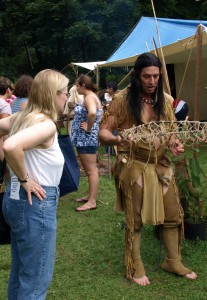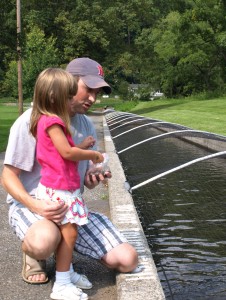Museum Of Indian Culture, Allentown Fish Hatchery Make For a Great Fall Outing
There’s an old joke that holds that when Squanto saw the Mayflower drop anchor off Plymouth Rock, his first reaction was “There goes the neighborhood.” I’ve never believed that Native Americans lived in peace with each other before the white man arrived, and we destroyed a paradise. There is ample evidence that the original tribes had their share of problems and wars. We just brought better weapons.
But there is also ample evidence that they had an extensive civilization that matched anything the Europeans brought to the North American continent. They had their own culture, traditions, histories and a way of looking at the earth than the newcomers almost destroyed, and they were here a very long time In fact, jasper mines have been unearthed in Lower and Upper Milford townships, Lehigh County, that have been authentically dated back more than 11,000 years.
The Museum of Indian Culture in Allentown is a great place to learn more about the ancient peoples of Eastern Pennsylvania. Opened 32 years ago in Allentown’s Little Lehigh Parkway as a primarily Lenni Lenape cultural center, it changed focus in 2005 to include all American Indians, said director Pat Rivera.
“The Lenni Lenape were actually removed from this area in the mid-1700s to make way for the colonial expansion. They are now primarily in Oklahoma and Canada,” she said. “But we have many Indians here for different reasons and we are open for all Indians to promote the heritage.”
The museum holds several festivals each year, including the popular Roasting Ears of Corn fest in August, which this year attracted more than 3,000 people. “Our festival is the oldest American Indian festival in Pennsylvania and we are proud to say that,” said Rivera.
Guests can enjoy Indian dance and music, purchase crafts and learn from Native Americans at the various booths and exhibits.
Though the Lenni Lenape – part of the Delaware tribes – were known to live in Eastern Pennsylvania, the region was actually home to several different Indian peoples, including the Shawnee, Iroquois and Seneca. The Museum of Indian Culture includes artifacts and exhibits from across the continent.
The Northeast Woodland Room lets visitors imagine making knapping tools from stone, cordage from plant fiber and fire from other primitive tools, and includes examples of items commonly traded among American Indians and settlers.
The Inter-Tribal room features a variety of American Indian artistry such as Lakota Morning Star quilt, beaded moccasins, knife sheath, Cheyenne Sash and Navajo sand art. There are programs for children and adults both at the museum and off-site.
Rivera notes that November is Native American Month and the museum will have an open house and workshops. Check the website for dates, times, costs and details. Saturday, Oct. 22 is “Fright Night At The Museum,” featuring tales of Indian ghosts, shapeshifters and other haunts.
“There are no ghosts in our building, but they have been seen outside,” Rivera said.
The museum is located on Fish Hatchery Road in Allentown, next door to the very popular Allentown Fish Hatchery. Also known as the Lil Le Hi Fish Hatchery, it is considered the oldest continuously operating trout hatchery in the United States. Patrons can feed the fish in a variety of breeding ponds or watch them swim in the small stream on the property.
“We love it here,” said Eric Molitoris of Alburtis, visiting with his 2-year-old daughter, Avery. “We probably come once a month since she learned how to walk.”
If You Go: The Museum of Indian Culture is located at 2825 Fish Hatchery Rd., Allentown. Admission is $5 for adults, $4 for seniors over 65 and children over 12. Children 11 and under are free. Hours are noon to 4 p.m. Friday through Sunday or by appointment.
What To Know: The annual open house is scheduled for noon to 4 p.m. Nov. 20.
Fact: Pennsylvania officials in 1730 placed a bounty of 30 to 50 British pounds on the head of any Lenape, but the final blow came after the historic Easton Conference in 1758, which led to the end of the French and Indian War but also resulted in the Forced March that removed the Delaware-Lenape Indians from their traditional homes in what is now Pennsylvania and New Jersey.









